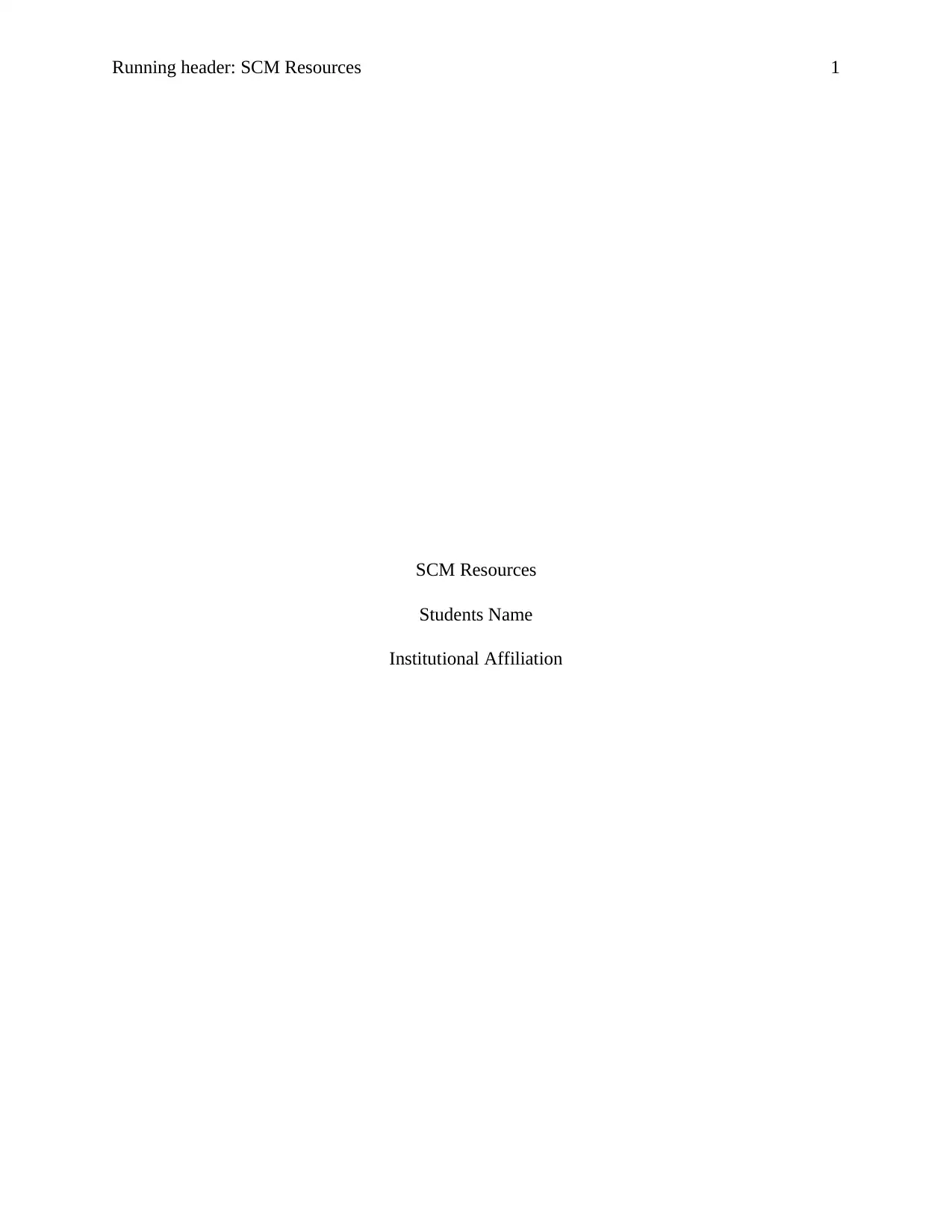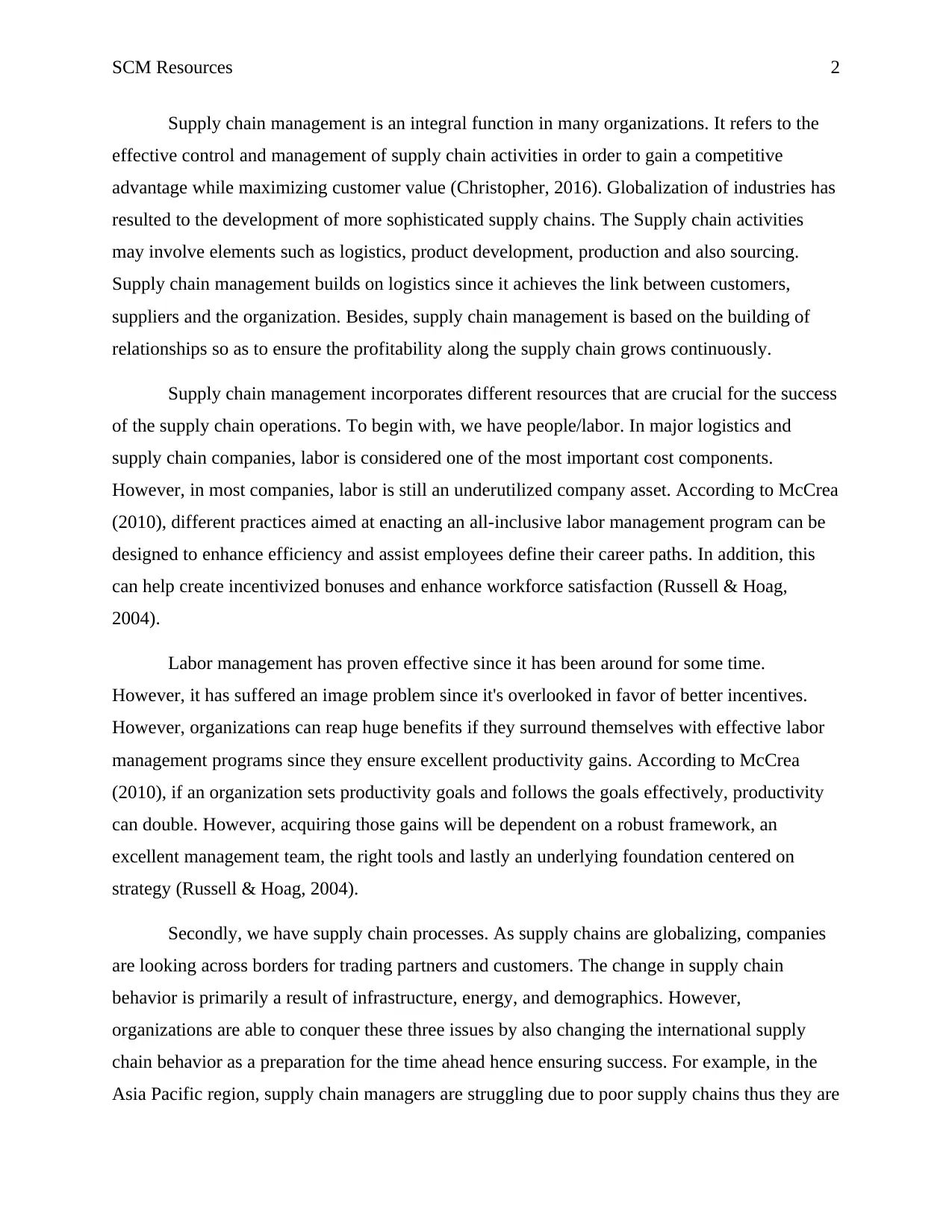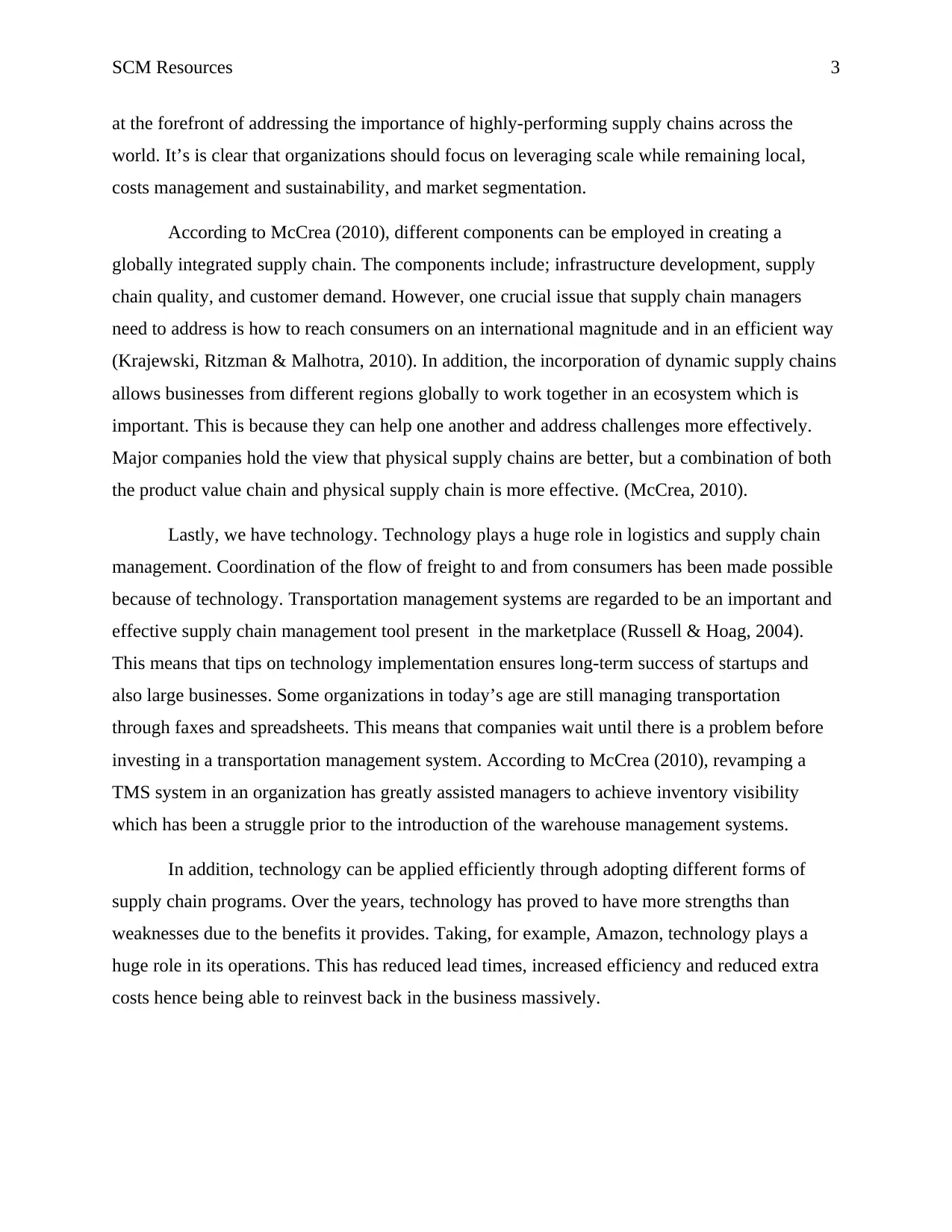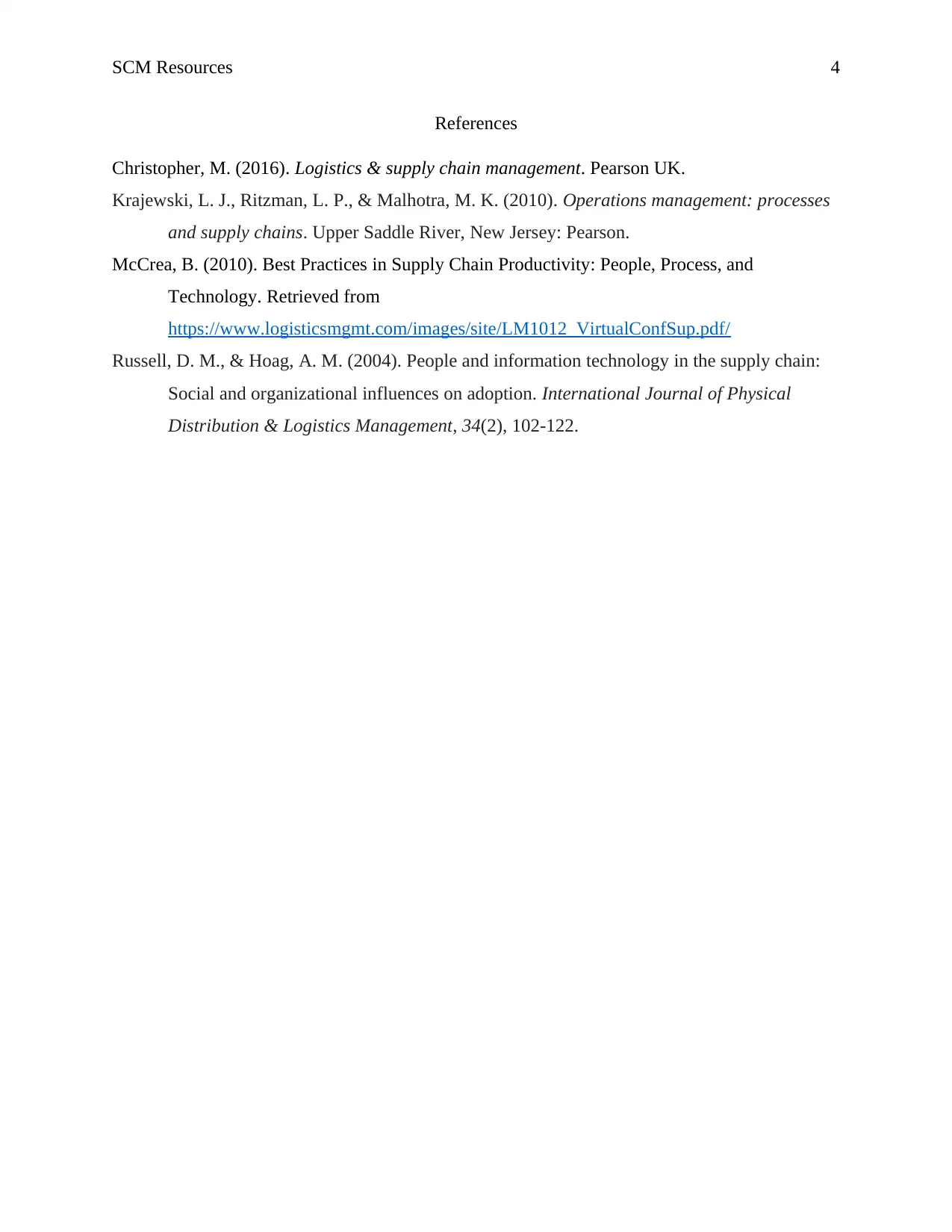An Examination of Key Resources in Supply Chain Management
VerifiedAdded on 2023/06/05
|4
|996
|127
Report
AI Summary
This report delves into the crucial resources that underpin effective supply chain management. It highlights the importance of people/labor, emphasizing the need for comprehensive labor management programs to enhance efficiency and employee satisfaction, leading to productivity gains. The report then explores supply chain processes, particularly in the context of globalization, emphasizing the need for organizations to adapt to international supply chain behaviors and leverage scale while managing costs and sustainability. Lastly, the report examines the role of technology, specifically Transportation Management Systems (TMS), in streamlining logistics, improving inventory visibility, and reducing lead times, drawing examples from companies like Amazon. The report underscores the interconnectedness of these resources for achieving competitive advantage and maximizing customer value in a globalized business environment.

Running header: SCM Resources 1
SCM Resources
Students Name
Institutional Affiliation
SCM Resources
Students Name
Institutional Affiliation
Paraphrase This Document
Need a fresh take? Get an instant paraphrase of this document with our AI Paraphraser

SCM Resources 2
Supply chain management is an integral function in many organizations. It refers to the
effective control and management of supply chain activities in order to gain a competitive
advantage while maximizing customer value (Christopher, 2016). Globalization of industries has
resulted to the development of more sophisticated supply chains. The Supply chain activities
may involve elements such as logistics, product development, production and also sourcing.
Supply chain management builds on logistics since it achieves the link between customers,
suppliers and the organization. Besides, supply chain management is based on the building of
relationships so as to ensure the profitability along the supply chain grows continuously.
Supply chain management incorporates different resources that are crucial for the success
of the supply chain operations. To begin with, we have people/labor. In major logistics and
supply chain companies, labor is considered one of the most important cost components.
However, in most companies, labor is still an underutilized company asset. According to McCrea
(2010), different practices aimed at enacting an all-inclusive labor management program can be
designed to enhance efficiency and assist employees define their career paths. In addition, this
can help create incentivized bonuses and enhance workforce satisfaction (Russell & Hoag,
2004).
Labor management has proven effective since it has been around for some time.
However, it has suffered an image problem since it's overlooked in favor of better incentives.
However, organizations can reap huge benefits if they surround themselves with effective labor
management programs since they ensure excellent productivity gains. According to McCrea
(2010), if an organization sets productivity goals and follows the goals effectively, productivity
can double. However, acquiring those gains will be dependent on a robust framework, an
excellent management team, the right tools and lastly an underlying foundation centered on
strategy (Russell & Hoag, 2004).
Secondly, we have supply chain processes. As supply chains are globalizing, companies
are looking across borders for trading partners and customers. The change in supply chain
behavior is primarily a result of infrastructure, energy, and demographics. However,
organizations are able to conquer these three issues by also changing the international supply
chain behavior as a preparation for the time ahead hence ensuring success. For example, in the
Asia Pacific region, supply chain managers are struggling due to poor supply chains thus they are
Supply chain management is an integral function in many organizations. It refers to the
effective control and management of supply chain activities in order to gain a competitive
advantage while maximizing customer value (Christopher, 2016). Globalization of industries has
resulted to the development of more sophisticated supply chains. The Supply chain activities
may involve elements such as logistics, product development, production and also sourcing.
Supply chain management builds on logistics since it achieves the link between customers,
suppliers and the organization. Besides, supply chain management is based on the building of
relationships so as to ensure the profitability along the supply chain grows continuously.
Supply chain management incorporates different resources that are crucial for the success
of the supply chain operations. To begin with, we have people/labor. In major logistics and
supply chain companies, labor is considered one of the most important cost components.
However, in most companies, labor is still an underutilized company asset. According to McCrea
(2010), different practices aimed at enacting an all-inclusive labor management program can be
designed to enhance efficiency and assist employees define their career paths. In addition, this
can help create incentivized bonuses and enhance workforce satisfaction (Russell & Hoag,
2004).
Labor management has proven effective since it has been around for some time.
However, it has suffered an image problem since it's overlooked in favor of better incentives.
However, organizations can reap huge benefits if they surround themselves with effective labor
management programs since they ensure excellent productivity gains. According to McCrea
(2010), if an organization sets productivity goals and follows the goals effectively, productivity
can double. However, acquiring those gains will be dependent on a robust framework, an
excellent management team, the right tools and lastly an underlying foundation centered on
strategy (Russell & Hoag, 2004).
Secondly, we have supply chain processes. As supply chains are globalizing, companies
are looking across borders for trading partners and customers. The change in supply chain
behavior is primarily a result of infrastructure, energy, and demographics. However,
organizations are able to conquer these three issues by also changing the international supply
chain behavior as a preparation for the time ahead hence ensuring success. For example, in the
Asia Pacific region, supply chain managers are struggling due to poor supply chains thus they are

SCM Resources 3
at the forefront of addressing the importance of highly-performing supply chains across the
world. It’s is clear that organizations should focus on leveraging scale while remaining local,
costs management and sustainability, and market segmentation.
According to McCrea (2010), different components can be employed in creating a
globally integrated supply chain. The components include; infrastructure development, supply
chain quality, and customer demand. However, one crucial issue that supply chain managers
need to address is how to reach consumers on an international magnitude and in an efficient way
(Krajewski, Ritzman & Malhotra, 2010). In addition, the incorporation of dynamic supply chains
allows businesses from different regions globally to work together in an ecosystem which is
important. This is because they can help one another and address challenges more effectively.
Major companies hold the view that physical supply chains are better, but a combination of both
the product value chain and physical supply chain is more effective. (McCrea, 2010).
Lastly, we have technology. Technology plays a huge role in logistics and supply chain
management. Coordination of the flow of freight to and from consumers has been made possible
because of technology. Transportation management systems are regarded to be an important and
effective supply chain management tool present in the marketplace (Russell & Hoag, 2004).
This means that tips on technology implementation ensures long-term success of startups and
also large businesses. Some organizations in today’s age are still managing transportation
through faxes and spreadsheets. This means that companies wait until there is a problem before
investing in a transportation management system. According to McCrea (2010), revamping a
TMS system in an organization has greatly assisted managers to achieve inventory visibility
which has been a struggle prior to the introduction of the warehouse management systems.
In addition, technology can be applied efficiently through adopting different forms of
supply chain programs. Over the years, technology has proved to have more strengths than
weaknesses due to the benefits it provides. Taking, for example, Amazon, technology plays a
huge role in its operations. This has reduced lead times, increased efficiency and reduced extra
costs hence being able to reinvest back in the business massively.
at the forefront of addressing the importance of highly-performing supply chains across the
world. It’s is clear that organizations should focus on leveraging scale while remaining local,
costs management and sustainability, and market segmentation.
According to McCrea (2010), different components can be employed in creating a
globally integrated supply chain. The components include; infrastructure development, supply
chain quality, and customer demand. However, one crucial issue that supply chain managers
need to address is how to reach consumers on an international magnitude and in an efficient way
(Krajewski, Ritzman & Malhotra, 2010). In addition, the incorporation of dynamic supply chains
allows businesses from different regions globally to work together in an ecosystem which is
important. This is because they can help one another and address challenges more effectively.
Major companies hold the view that physical supply chains are better, but a combination of both
the product value chain and physical supply chain is more effective. (McCrea, 2010).
Lastly, we have technology. Technology plays a huge role in logistics and supply chain
management. Coordination of the flow of freight to and from consumers has been made possible
because of technology. Transportation management systems are regarded to be an important and
effective supply chain management tool present in the marketplace (Russell & Hoag, 2004).
This means that tips on technology implementation ensures long-term success of startups and
also large businesses. Some organizations in today’s age are still managing transportation
through faxes and spreadsheets. This means that companies wait until there is a problem before
investing in a transportation management system. According to McCrea (2010), revamping a
TMS system in an organization has greatly assisted managers to achieve inventory visibility
which has been a struggle prior to the introduction of the warehouse management systems.
In addition, technology can be applied efficiently through adopting different forms of
supply chain programs. Over the years, technology has proved to have more strengths than
weaknesses due to the benefits it provides. Taking, for example, Amazon, technology plays a
huge role in its operations. This has reduced lead times, increased efficiency and reduced extra
costs hence being able to reinvest back in the business massively.
⊘ This is a preview!⊘
Do you want full access?
Subscribe today to unlock all pages.

Trusted by 1+ million students worldwide

SCM Resources 4
References
Christopher, M. (2016). Logistics & supply chain management. Pearson UK.
Krajewski, L. J., Ritzman, L. P., & Malhotra, M. K. (2010). Operations management: processes
and supply chains. Upper Saddle River, New Jersey: Pearson.
McCrea, B. (2010). Best Practices in Supply Chain Productivity: People, Process, and
Technology. Retrieved from
https://www.logisticsmgmt.com/images/site/LM1012_VirtualConfSup.pdf/
Russell, D. M., & Hoag, A. M. (2004). People and information technology in the supply chain:
Social and organizational influences on adoption. International Journal of Physical
Distribution & Logistics Management, 34(2), 102-122.
References
Christopher, M. (2016). Logistics & supply chain management. Pearson UK.
Krajewski, L. J., Ritzman, L. P., & Malhotra, M. K. (2010). Operations management: processes
and supply chains. Upper Saddle River, New Jersey: Pearson.
McCrea, B. (2010). Best Practices in Supply Chain Productivity: People, Process, and
Technology. Retrieved from
https://www.logisticsmgmt.com/images/site/LM1012_VirtualConfSup.pdf/
Russell, D. M., & Hoag, A. M. (2004). People and information technology in the supply chain:
Social and organizational influences on adoption. International Journal of Physical
Distribution & Logistics Management, 34(2), 102-122.
1 out of 4
Related Documents
Your All-in-One AI-Powered Toolkit for Academic Success.
+13062052269
info@desklib.com
Available 24*7 on WhatsApp / Email
![[object Object]](/_next/static/media/star-bottom.7253800d.svg)
Unlock your academic potential
Copyright © 2020–2025 A2Z Services. All Rights Reserved. Developed and managed by ZUCOL.





